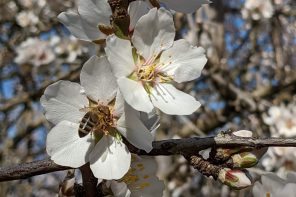The Holding Yard Dilemma
It’s no secret that holding yards are what make almond pollination possible.
Holding yards?
Unless a beekeeper is very, very lucky and finds a spot in the western foothills with blooming crops long into the winter (and usually some distance from any orchards, and always hard to find), a holding yard is a patch of dry, mostly level, accessible land (assuming you don’t get that 100 year storm and the whole thing becomes a lake, or worse a river) somewhere in the vicinity of the almond orchard the colonies are ultimately destined to visit. Beekeepers deliver their colonies to holding yards starting as early as the previous October to as late as a week before they enter the orchards in early February.
Holding yard land is idle most or all of the time, other than, perhaps, hosting colonies from other beekeepers, so the bees can be brought in, managed or ignored, and then left alone for a bit, maybe managed again, until they are moved from the holding yard to the orchard just before the earliest blooming varieties of almonds start showing flowers. That management action is primarily feeding, feeding, feeding.
Colonies that arrive first…usually from the Midwest where winters come early and getting out before they get snowed in is mandatory…are generally at the low end of their season…the queen has slowed or stopped laying, there’s little or no brood, and most of the bees are winter, fat-body bees…not active foragers…ready to be idle for a few months. For these colonies the beekeeper’s job is clear – fool Mother nature. Convert that population of winter bees to a growing, thriving population of spring bees…ready to fly, ready to forage, ready to be bees. And do it in a location where nothing grows, there’s no water, it’s warm enough to fly…but there’s nothing to fly to and with shorter and shorter days telling the bees that flying is a mistake anyway. Remember that commercial … It’s Not Nice To Fool Mother Nature? Beekeepers do it routinely with sugar syrup and pollen substitute. Kind of.
Those colonies that arrive later, from locations where they have been on natural forage and able to fly are often in better shape than those who came early, ate only sugar and pollen substitute for weeks and months and stayed long. That only makes sense.
It’s plain and simple…almonds are a Mediterranean climate crop…think Spain…and spring and almonds and bees wake up long before they do in Minnesota, North Dakota or Montana. In fact, they hardly ever slow down, winter-wise. You don’t have to fool a Spanish bee, or one from Florida, the gulf region or southern Texas. They know the score and the time of year. Almonds work for them pretty well.
But many almond bees are Midwest bees, and for them if almond pollination is an annual event so is sitting in holding yards. Along with that there’s the oft heard comparison of holding yards and hospital emergency waiting rooms. If there’s a problem in your community it’s sitting in that room, waiting for you to walk in, sit down and…well, wait. Spread your bees among all the bees in the yard…and see what you come home with.
Sharing pests and predators aside, Midwest bees do respond to sugar syrup and pollen substitute but not as well nor as fast as they would to a thousand acres of mustard, wild flowers or blooming alfalfa. But those crops need water, and water is a premium commodity almost everywhere in California. So growers are unable, or unwilling to part with some of their almond tree water to produce honey bee forage. Especially if it’s for a short, short time. Sometimes, when pollination is done, beekeepers head back to the holding yards because going home…back to the cold and snow of March…isn’t an attractive option. After living for a month in an ocean of bloom…providing it didn’t rain, blow or get cold…the colonies are ready to go…they’ve been building, growing and doing fine for quite awhile…but back at the holding yards they came from…once again it’s lots of nothing to do or places to go.
The easy, obvious answer is that growers could be investing in crops bees can use before and after almond bloom. Maybe, if there was a Garden Of Paradise awaiting beekeepers and their bees that was full of forage, safe from pesticides and easy to get to…they could charge less for pollination because they’d have to pay less to get those winter bees thinking of spring. What do you think?








